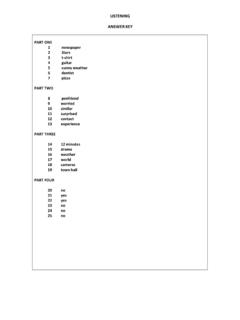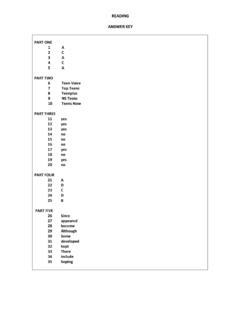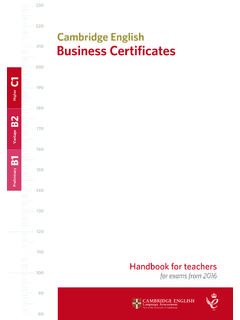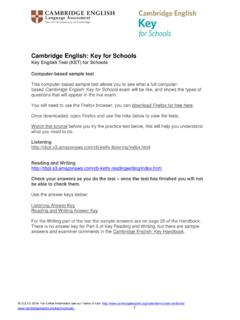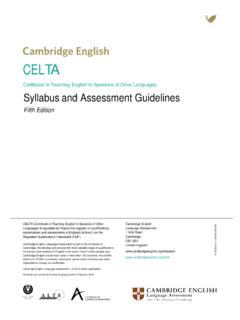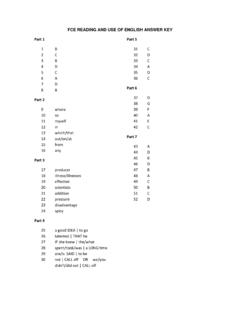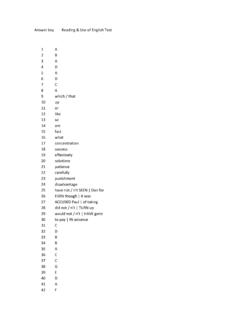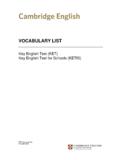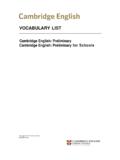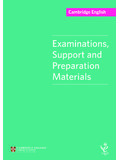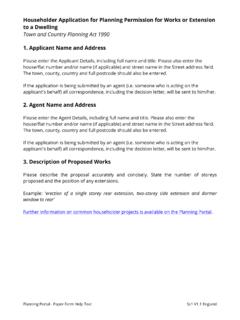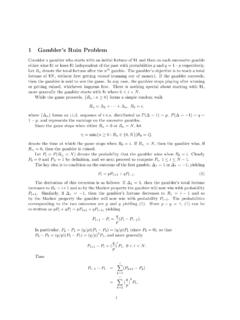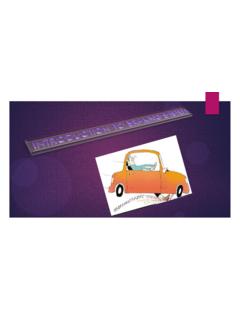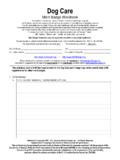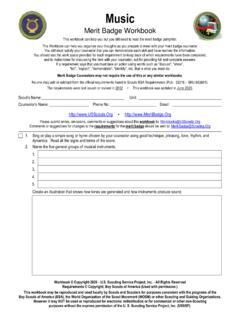Transcription of IELTS Academic Reading Task Type 5 (Matching Headings ...
1 UCLES 2009. This material may be photocopied (without alteration) and distributed for classroom use provided no charge is made. For further information see our Terms and Conditions IELTS Academic Reading Task Type 5 (Matching Headings ) Activity teacher s notes Description An activity that introduces task type 5 and the skills needed for it followed by practice of a task type 5 with the class working together to complete it correctly. Time required: 60 minutes Additional materials required: photocopies of list of Headings for each student OHT of first paragraph of Reading text cut up paragraphs of the remainder of the text (enough for one for each student; depending on class size you may need multiple paragraphs) cut-ups of each heading enlarged blu-tack Aims: to raise awareness of the skills needed to answer task type 5, including identifying topic sentences, understanding the main idea and choosing the most appropriate heading to practise these skills and to complete a task type 5 Procedure 1.
2 Hand out the worksheet and discuss the first three questions on it with the students as a whole class. Explain that the students are going to work on a task which involves matching Headings to sections of a text. 2. Show the first paragraph of the Reading text on an OHT. Ask students to find the topic sentence. Then ask them to skim the rest of the paragraph to see how closely the paragraph as a whole relates to the topic sentence. Elicit a few possible Headings for the paragraph and write them on the board. 3. Hand out one paragraph to each student. If there are more students than paragraphs, more than one student can have the same paragraph. If there are fewer students than paragraphs, give stronger students two paragraphs. 4. Ask students to skim their paragraph, locating the topic sentence and then decide what the main idea is.
3 5. While students are Reading , stick each heading on the white board or around the walls of the classroom. Make sure they are large enough for students to read easily. 6. Hand out a list of Headings to each student and ask them to look through them. 7. Students go and stand next to the heading which they think best fits their paragraph. At this point there may be students claiming one heading for different paragraphs. Note which paragraphs and heading these are. UCLES 2009. This material may be photocopied (without alteration) and distributed for classroom use provided no charge is made. For further information see our Terms and Conditions 8. Students sit down again. Hand out Reading text. Give students 3 minutes to skim read the whole text.
4 9. Direct students to the paragraphs which were claimed by more than one student in the previous step. Students read the first problem paragraph. Ask the owner of the paragraph to say which heading they thought it was and why. Encourage students to agree or disagree (providing explanation) with this. Continue with the other problem paragraphs, recording the student answers on the board. 10. After the class has decided on their answers, write them on the board (there may still be disagreement, in which case record all possible answers on the board). 11. Ask students to go back to the text and check each answer on the board to see if they agree with it. Add/remove/change any answers on the board which students now want.
5 12. Tell the students the correct answers. Students go back to the text and find why each answer is correct. 13. Ask students to discuss with their partner what procedure they would use to do a task type 6 alone. Elicit a few ideas and direct the students towards concluding that it is advisable to skim read each paragraph and then read the Headings to find a suitable one. Point out that if they start with the Headings and scan for the key words in them, they will be finding specific information rather than the main idea. 14. Give students another task type 5 for homework. UCLES 2009. This material may be photocopied (without alteration) and distributed for classroom use provided no charge is made. For further information see our Terms and Conditions IELTS Academic Reading Task Type 5 (Matching Headings ) Activity answer keys Key to Classroom Activity 1.
6 A heading is a short sentence or expression which explains the most important point in a text 2. The main point of a paragraph is usually found in the topic sentence, which may be the first or last sentence of the paragraph, or less commonly, in the middle. 3. Spend a minute or so getting the main idea about the text as a whole by skimming it and looking at any titles, sub-titles and illustrations there are. Key to Sample Task 1. v 2. vii 3. ii 4. iv 5. i UCLES 2009. This material may be photocopied (without alteration) and distributed for classroom use provided no charge is made. For further information see our Terms and Conditions IELTS Reading Task Type 5 (Matching Headings ) Activity Student s Worksheet 1. What is a heading? What is its purpose? How does it relate to a text?
7 2. Which part of a paragraph often contains the main idea? 3. What is the first thing you should do with a Reading text for task type 5? UCLES 2009. This material may be photocopied (without alteration) and distributed for classroom use provided no charge is made. For further information see our Terms and Conditions IELTS Academic Reading Task Type 5 (Matching Headings ) Activity Sample Task Questions 1 5 Sample Passage 6 has six sections A-F. Choose the correct heading for sections A-D and F from the list of Headings below. Write the correct number i-ix in boxes 1-5 on your answer sheet. List of Headings i ii iii iv v vi vii viii ix The probable effects of the new international trade agreement The environmental impact of modern farming Farming and soil erosion The effects of government policy in rich countries Governments and management of the environment The effects of government policy in poor countries Farming and food output The effects of government policy on food output The new prospects for world trade 1 Section A 2 Section B 3 Section C 4 Section D Example Section E vi 5 Section F UCLES 2009.
8 This material may be photocopied (without alteration) and distributed for classroom use provided no charge is made. For further information see our Terms and Conditions IELTS Academic Reading Task Type 5 (Matching Headings ) Activity Sample Task Section A The role of governments in environmental management is difficult but inescapable. Sometimes, the state tries to manage the resources it owns, and does so badly. Often, however, governments act in an even more harmful way. They actually subsidise the exploitation and consumption of natural resources. A whole range of policies, from farm-price support to protection for coal-mining, do environmental damage and (often) make no economic sense. Scrapping them offers a two-fold bonus: a cleaner environment and a more efficient economy.
9 Growth and environmentalism can actually go hand in hand, if politicians have the courage to confront the vested interest that subsidies create. Section B No activity affects more of the earth's surface than farming. It shapes a third of the planet's land area, not counting Antarctica, and the proportion is rising. World food output per head has risen by 4 per cent between the 1970s and 1980s mainly as a result of increases in yields from land already in cultivation, but also because more land has been brought under the plough. Higher yields have been achieved by increased irrigation, better crop breeding, and a doubling in the use of pesticides and chemical fertilisers in the 1970s and 1980s. Section C All these activities may have damaging environmental impacts.
10 For example, land clearing for agriculture is the largest single cause of deforestation; chemical fertilisers and pesticides may contaminate water supplies; more intensive farming and the abandonment of fallow periods tend to exacerbate soil erosion; and the spread of monoculture and use of high-yielding varieties of crops have been accompanied by the disappearance of old varieties of food plants which might have provided some insurance against pests or diseases in future. Soil erosion threatens the productivity of land in both rich and poor countries. The United States, where the most careful measurements have been done, discovered in 1982 that about one-fifth of its farmland was losing topsoil at a rate likely to diminish the soil's productivity. The country subsequently embarked upon a program to convert 11 per cent of its cropped land to meadow or forest.
